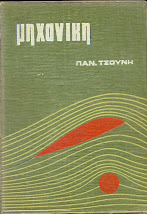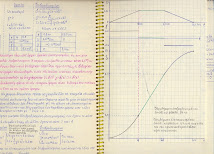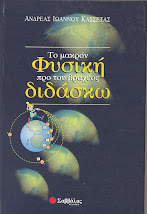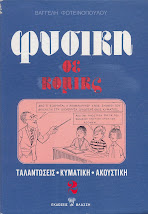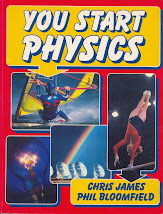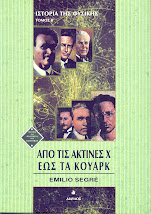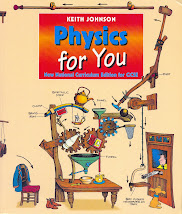Δευτέρα 31 Μαΐου 2010
Τα αντίρροπα ρεύματα επαγωγής στο πλησίασμα και στην απομάκρυνση του μαγνήτη.
Ο ηλεκτρομαγνητισμός συνδεμένος με τη μουσική Θεοδωράκη
Πως είπε ο Μίκης εξόριστος στη Ζάτουνα...
Απόψε "πάντρεψα" τη μουσική μου με την ποίηση του Σικελιανού, όταν συνέθεσε το Πνευματικό Εμβατήριο.
Ετικέτες
Βιντεοπείραμα,
Ηλεκτρομαγνητισμός
Κυριακή 30 Μαΐου 2010
Θέματα και απαντήσεις στη Φυσική Πανελλήνιων του 2010.
 Θέματα και απαντήσεις από την εφημερίδα
Θέματα και απαντήσεις από την εφημερίδαΕΘΝΟΣ


Το Δ4 στο βιβλίο των Timosenko and Young "Engineering Mechanics" τέταρτη έκδοση (1956) πρωτη έκδοση 1938.
Πολλές από τις ασκήσεις του βιβλίου αυτού βρίσκονται σε ελληνικά και ξένα βιβλία φυσικής από τότε, μια και θεωρείται βάση αναφοράς, αλλά το συγκεκριμένο μόλις σε κανά δυο τρια.Ο Timosenko επίτιμος καθηγητής Μηχανολογίας στο Πανεπ. του Stanford, o Young καθηγητής Μηχανολογίας στο ίδιο Πανεπιστήμιο. Το βιβλίο προορίζοταν κυρίως για φοιτητές Πολυτεχνείων, μελλοντικούς μηχανικούς και δίνει έμφαση στην στατική (δικτυώματα) μηχανές, διωστήρες και βέβαια αρκετά με ανωτερα μαθηματικά (παράγωγοι, ολοκληρώματα, αφού ήταν ένα πανεπιστημιακό βιβλίο)
Δεν είναι τυχαίο ότι η συγκεκριμένη άσκηση δεν υπάρχει στα κλασικά συγγράμματα "καθαρής" φυσικής όπως Χαλιντέϊ - Ρένσικ, Young εκδόσεις Παπαζήση, Berkley, Αλόνσο Φιν, W. Ford εκδόσεις Πνευματικού, Serway, και σε άλλα ξενόγλωσσα βιβλία ανώτερου λυκειακού επιπέδου.
Επομένως αν τόσοι έγκυροι συγγραφείς δεν το επέλεξαν για τα βιβλία τους σημαίνει ότι πρόκειται για ένα ειδικό θέμα, κατάλληλο για την εκπαίδευση μηχανολόγων μηχανικών.
Και αφού επιλέχτηκε, καλό θα ήτο να οδηγηθούν τουλάχιστο οι ξύπνιοι/ες διαγωνιζόμενοι/ες μαθητές/τριες να αποφύγουν διάφορες παγίδες με λογική σειρά ερωτημάτων και το βασικότερο όχι τόσο φορτωμένο σαν θέμα, σε αντίθεση με το ελλειποβαρές τρίτο θέμα.
Για μια ακόμη φορά ... της νύχτας τα καμώματα...
 1) Λύσεις από το φροντιστήριο Δυαδικό
1) Λύσεις από το φροντιστήριο Δυαδικό
Πέμπτη 20 Μαΐου 2010
Δευτέρα 17 Μαΐου 2010
Από τον μαγνητισμό στον ηλεκτρισμό
Πλησιάζοντας ή απομακρύνοντας μεταξύ τους μαγνήτη - πηνίο, και για όσο χρόνο διαρκεί η κίνηση.
Οσο ταχύτερη η κίνηση τόσο μεγαλύτερη η τάση από επαγωγή.
Βρείτε περισσότερα βίντεο σαν αυτό στο Διδάσκοντας Φυσικές Επιστήμες
Οσο ταχύτερη η κίνηση τόσο μεγαλύτερη η τάση από επαγωγή.
Βρείτε περισσότερα βίντεο σαν αυτό στο Διδάσκοντας Φυσικές Επιστήμες
Ετικέτες
Βιντεοπείραμα,
Ηλεκτρομανητική Επαγωγή,
Πείραμα
Σάββατο 8 Μαΐου 2010
Δεκαοχτώ από 54 διάσημους Φυσικούς




19) Hans Bethe (1906-2005) Birthplace: Strassburg, Germany
(Nobel Prize: 1967)
Hans Bethe discovered why stars shine. In 1938 he proposed (and calculated) a sequence of nuclear reaction in stars that would turn hydrogen into helium, thus providing the needed energy. Two generations of physics students learned nuclear physics from Bethe’s monumental articles in The Reviews of Modern Physics. He headed the theoretical physics section at Los Alamos.
20) Niels Bohr (1885-1962) Birthplace: Copenhagen, Denmark
(Nobel Prize: 1922)
He was the guru of quantum mechanics. By requiring quantized angular momentum, Bohr developed the first successful theory of the hydrogen atom and its spectra. Throughout the late 1920s and 1930s, his institute in Copenhagen became the focal point for the small band of theoretical physicists who developed the quantum theories. His philosophical theme was “complimentarity”, dual nature of reality.
21) Ludwig Boltzmann (1844-1906) Birthlpace: Vienna, Austria
Boltzmann established the statistical interpretation of entropy and the second law of thermodynamics. He calculated the number of arrangements of momentum and energy possible for a group of molecules with a fixed total energy. From his theory of a microworld of interacting particles, Boltzmann successfully predicted macroscopic features of thermodynamics, and thus demonstrated the likelihood of atomicity.
22) Max Born (1882-1970) Birthplace: Breslau, Germany
(Nobel Prize: 1954)
Max Born was a pioneer in the development of quantum theory. He was awarded the Nobel Prize “for his fundamental research in quantum mechanics, especially for his statistical interpretation of the square of Schrodinger’s wave function as the particle’s probability distribution function”. Born was a close friend of Albert Einstein’s; they agreed to disagree about “God plays dice with the universe”.
23) Louis de Broglie (1892-1987) Birthplace: Dieppe, France
(Nobel Prize: 1929)
De Broglie used Einstein’s E=mc2 along with Plank’s equation E=hf to show that any particle there should be an associated wave, the wavelength of which depends on the particle’s momentum. The revolutionary nature of the de Broglie’s theory was not well appreciated until Einstein called it to the attention of the physics community. Ultimately, de Broglie’s work served as the foundation for the development of wave mechanics by Erwin Shrodinger and others.
24) A.H. Compton (1892-1962) Birthplace: Wooster, OH
(Nobel Prize: 1927)
In his experiments on the scattering of x-rays, Compton found that some of the scattered radiation suffered an increase in wavelength. He accounted for this by presuming that radiation has a particle nature. (he coined the name photon) and that in collisions with electrons the photons lose energy. This work gave support to Einstein’s theory of the particle nature of light.
25) Nicolaus Copernicus (1473-1543) Birthplace: Torun, Poland
In his book On the Revolutions, Copernicus moved our Earth from the center of the universe to an orbit around the Sun, and a position as a minor planet. The book is not only a remarkable analysis of astronomical observations, but is also a courageous denial of the religious – philosophical dogma of his age.
26) Marie Curie (1867-1934) Birthplace: Warsaw, Poland
(Nobel Prizes: 1903, Physics; 1911, Chemistry)
Marie (Maria Sklodowska) Curie received her early scientific training from her father in Warsaw, then went to Cracow, and finally to the Sorbonne in Parris. After the death of her husband, Pierre Curie, she succeeded to his professorship and developed a major institute for the study of radioactivity.
27) Paul Dirac (1902-1984) Birthplace: Bristol, England
(Nobel Prize: 1933)
Dirac merged quantum mechanics and relativity. His equations predicted the existence of a whole other world of antiparticles. Dirac was a shy man who usually worked alone. His guide to research and criterion for validity was the beauty of the equations.
28) Albert Einstein (1879-1955) Birthplace: Ulm, Germany
(Nobel Prize: 1921)
The most revolutionary mind of the 20th century. In 1905 he published three papers in the same journal: one on Brownian motion clinched the case for the existence of atoms; one explained the photoelectric effect; and the third presented the special theory of relativity. Ten years later his general theory of relativity supplanted Newton’s gravitation with a vastly different view of space – time and the universe.
29) Michel Faraday (1791-1867) Birthplace: London, England
Son of a blacksmith, apprenticed to a bookbinder, self-educated, Faraday was a laboratory assistant to Sir Humphry Davy, the great chemist. Yet Davy later said, “My greater discovery was Faraday”. Faraday originated our ideas of electromagnetic fields, discovered the induction of electric fields, and created the first generator. He worked out and demonstrated the laws of electrolysis, and found fundamental relationships between light and electromagnetism in matter.
30) Enrico Fermi (1901-1954) Birthplace: Rome, Italy
(Nobel Prize: 1938)
Master of both experimental and theoretical techniques, Fermi helped explain beta decay in terms of Pauli’s neutrino. He realized the practical consequences of nuclear fission and created the first nuclear reactor in Chicago, which led to the construction of the first nuclear bomb. Fermi had a legendary ability to do mental calculations and obtain order of magnitude answers to problems of any kind.
31) Maria Goeppert – Mayer (1906-1972) Birthplace: Kattowitz, Germany
(Nobel Prize: 1963)
Goeppert – Mayer calculated the structure of atomic nuclei, relating the number of protons and neutrons to the stability and energy levels of the nuclei. She showed that the nucleus is not an amorhous soup of particles, but has a shell structure. She made many other important contributions to theoretical physics, but did so without academic position because of nepotism rules in force at the time.
32) Werner Heisenberg (1901-1976) Birthplace: Wurzurg, Germany
(Nobel Prize: 1932)
One of the founders of quantum mechanics, Heisenberg formulated the relationships between measurable quantities in terms of matrix algebra, equivalent to Shrodinger’s wave equations. One of the inescapable consequences of his theory is that certain linked quantities have linked uncertainties in their measured values.
33) Edwin Hubble (1889-1953) Birthplace: Marshfield, MO
Some people discover new worlds: Hubble discovered the universe. He proved that galaxies exist beyond our own, and that are all fleeing from each other. From his measurements of galastic redshifts, he determined the rate of expansion of the universe, and thus its age. When Einstein heard about Hubble’s results, he said that not realizing the expansion of the universe was his “greatest blunder”.
34) Elmer Samuel Imes (1883-1941) Birthplace: Memphis, TN
In 1918 Imes became the second African – American to earn a Ph.D. in physics. He worked under Harrison Randall at the University of Michigan on measuring high – resolution infrared spectra of diatomic molecules. Imes’ papers of 1919-1920 were the first research publications produced by an African – American physicist. They provided the accurate determination of interatomic distances in molecules and established that quantum theory is applicable to the study of molecular structure and behavior.
35) Max von Laue (1879-1960) Birthplace: Pfaffendorf, Germany
(Nobel Prize: 1914)
Von Laue showed that the layers of atoms forming a crystal could serve as a diffraction grating for x rays. This discovery, which Einstein called “one of the most beautiful in physics”, provide a method of determining the wavelength of the x-rays and of the structure of crystals. Von Laue was an early advocate of Albert Einstein’s theory of relativity.
36) Hendrik A. Lorentz (1853-1928) Birthplace: Arnhem, The Netherlands
(Nobel Prize: 1902)
Before the existence of electrons had been demonstrated, Lorentz proposed that oscillations of electric charge in the atom result in the emission of light waves. He shared the physics Nobel Prize with his student Piert Zeeman, who demonstrated the effect on the wavelength of such emitted light. Lorentz is also famous for his work to explain the null result of the Michelson – Morley experiment. The Lorentz transformations form the basis of Einstein’s special theory of relativity.
Ετικέτες
Ιστορία Φυσικής,
Φημισμένοι Φυσικοί
Εγγραφή σε:
Σχόλια (Atom)














